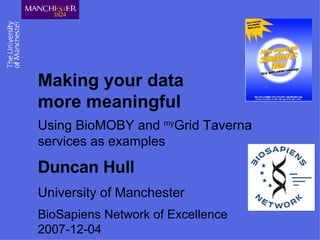Making data more meaningful with BioMOBY and my Grid services
•Descargar como PPT, PDF•
4 recomendaciones•4,593 vistas
The document summarizes the use of semantic web standards and ontologies to add meaning and enable discovery of bioinformatics web services. It provides examples using the InterProScan protein domain identifier service, described through standards like XML, RDF and OWL. Registries like BioMOBY and myGrid are discussed that annotate services with ontologies to enable more powerful searches beyond just name or description. Reasoners can also check annotations for consistency and infer new facts to further enhance discovery.
Denunciar
Compartir
Denunciar
Compartir

Recomendados
Más contenido relacionado
La actualidad más candente
La actualidad más candente (8)
Apache Solr, il motore di ricerca enterprise open source

Apache Solr, il motore di ricerca enterprise open source
Working with data.open.ac.uk, the Linked Data Platform of the Open University

Working with data.open.ac.uk, the Linked Data Platform of the Open University
A Practical Ontology for the Large-Scale Modeling of Scholarly Artifacts and ...

A Practical Ontology for the Large-Scale Modeling of Scholarly Artifacts and ...
Destacado
Destacado (6)
Chemical named entity recognition and literature mark-up

Chemical named entity recognition and literature mark-up
If Web Services are the Answer, What's The Question

If Web Services are the Answer, What's The Question
Defrosting the Digital Library: A survey of bibliographic tools for the next ...

Defrosting the Digital Library: A survey of bibliographic tools for the next ...
Similar a Making data more meaningful with BioMOBY and my Grid services
Similar a Making data more meaningful with BioMOBY and my Grid services (20)
The scripting library: Combining data and information in the library

The scripting library: Combining data and information in the library
Integrating a Domain Ontology Development Environment and an Ontology Search ...

Integrating a Domain Ontology Development Environment and an Ontology Search ...
Tech. session : Interoperability and Data FAIRness emerges from a novel combi...

Tech. session : Interoperability and Data FAIRness emerges from a novel combi...
Finding knowledge, data and answers on the Semantic Web

Finding knowledge, data and answers on the Semantic Web
Exploring and using the Semantic Web - SSSW09 tutorial

Exploring and using the Semantic Web - SSSW09 tutorial
Semantic web technologies applied to bioinformatics and laboratory data manag...

Semantic web technologies applied to bioinformatics and laboratory data manag...
Más de Duncan Hull
Más de Duncan Hull (19)
Embedding employability in the Computer Science curriculum

Embedding employability in the Computer Science curriculum
Wikipedia at the Royal Society: The Good, the Bad and the Ugly

Wikipedia at the Royal Society: The Good, the Bad and the Ugly
Improving the troubled relationship between Scientists and Wikipedia 

Improving the troubled relationship between Scientists and Wikipedia
Bibliography 2.0: A citeulike case study from the Wellcome Trust Genome Campus

Bibliography 2.0: A citeulike case study from the Wellcome Trust Genome Campus
Text mining tools for semantically enriching scientific literature

Text mining tools for semantically enriching scientific literature
Último
Último (20)
The Future Roadmap for the Composable Data Stack - Wes McKinney - Data Counci...

The Future Roadmap for the Composable Data Stack - Wes McKinney - Data Counci...
The Ultimate Guide to Choosing WordPress Pros and Cons

The Ultimate Guide to Choosing WordPress Pros and Cons
Use of FIDO in the Payments and Identity Landscape: FIDO Paris Seminar.pptx

Use of FIDO in the Payments and Identity Landscape: FIDO Paris Seminar.pptx
Time Series Foundation Models - current state and future directions

Time Series Foundation Models - current state and future directions
How to Effectively Monitor SD-WAN and SASE Environments with ThousandEyes

How to Effectively Monitor SD-WAN and SASE Environments with ThousandEyes
Unleashing Real-time Insights with ClickHouse_ Navigating the Landscape in 20...

Unleashing Real-time Insights with ClickHouse_ Navigating the Landscape in 20...
A Journey Into the Emotions of Software Developers

A Journey Into the Emotions of Software Developers
TrustArc Webinar - How to Build Consumer Trust Through Data Privacy

TrustArc Webinar - How to Build Consumer Trust Through Data Privacy
TeamStation AI System Report LATAM IT Salaries 2024

TeamStation AI System Report LATAM IT Salaries 2024
Genislab builds better products and faster go-to-market with Lean project man...

Genislab builds better products and faster go-to-market with Lean project man...
So einfach geht modernes Roaming fuer Notes und Nomad.pdf

So einfach geht modernes Roaming fuer Notes und Nomad.pdf
Enhancing User Experience - Exploring the Latest Features of Tallyman Axis Lo...

Enhancing User Experience - Exploring the Latest Features of Tallyman Axis Lo...
Digital Identity is Under Attack: FIDO Paris Seminar.pptx

Digital Identity is Under Attack: FIDO Paris Seminar.pptx
Making data more meaningful with BioMOBY and my Grid services
- 1. Making your data more meaningful Using BioMOBY and my Grid Taverna services as examples Duncan Hull University of Manchester BioSapiens Network of Excellence 2007-12-04
- 6. Back to the Stack
- 20. Semantic Web Services in a nutshell User driven Bit of an afterthought Lots of user generated metadata Metadata yes Kind of Yes Yes Yes! Community participation possibly? A bit No no no! Reasoning / semantics Maybe? no yes API? Taverna 2 / myExperiment myGrid BioMOBY
